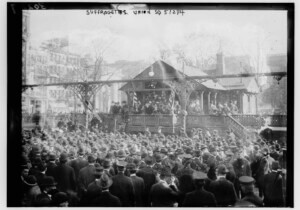This is the second entry in Architects Talking Ethics, an advice column that intends to host a discussion of the values that architects embody or should embody. It aims to answer real-world ethical questions posed by architects, designers, students, and professors.
We, as the three initial authors of this column, think the profession is way behind in how it addresses ethics. We think architects should explore our own ethics with the breadth and depth that other fields have done for a long time.
In our teaching, we’ve sensed an eagerness among students to talk about ethics. The “ethical turn” in our profession that has a lot to do with equity and environmental responsibility, yet the typical curriculum has, maybe, one lecture on ethics in the pro-practice course. The amount of time and attention we give to ethics in school as well as in the profession does not align with its importance. Maybe, with this column, we can encourage more interest.
What are the ethics of architects? What questions about ethics and architecture do you have? What ethical dilemmas do you face or have faced or anticipate facing?
Our second item concerns taking on architectural work that one disagrees with. We tackle the question from three vantage points.
Send your questions to ethics@archpaper.com for consideration in future columns.
What do you do when asked to work on a commission with which you disagree?
There are at least three ways to answer that question. You could accept it and keep your disagreement to yourself, accept it but try to change or improve upon what you disagree with, or refuse to work on it and accept the consequences. If you are a licensed professional with a charter from the government to protect the public, however, you are not really allowed to put the interests of the client before the interests of the public. So the very first question you should ask yourself in such a situation is: Is this in the interest of the public?
In answering the initial question, you might have a different answer if you are a partner deciding whether or not to take a commission or an employee deciding to accept an assignment. As a partner, your decisions affect the finances of the people who work in the company. Like most ethical dilemmas, the pros and cons are not always black and white. You should talk about them with your colleagues and start a conversation about the complexity of ambiguous ethical situations, as we are trying to do with this column.
The Hancock tower offers a good example of the question for a partner of a firm. The project size was illegal according to the City of Boston, and the AIA considered its impacts on Copley Square to be grossly immoral. In fact, I. M. Pei walked away from the commission, but his partner, Henry Cobb, was willing to take it on because he feared that some other architect who cared less about Boston would take the commission and would do a lesser job than his firm.
A lot of architects think similarly: “If I turn down a commission, somebody else is going to do it anyway, so I might as well try to make it as good as I can.” This rationale, while common, is deeply problematic and only makes sense if you think that the goal of architecture is to be better than your competition. We as a profession could have much more social impact if we thought differently and had an ongoing, robust conversation about ethics. But we don’t have a coherent profession with defined principles. Had Cobb known that nobody else would take the commission, he might have turned it down.
In contrast, we can look at how the medical profession dealt with the death penalty in California. When the state scheduled executions, no doctor was willing to administer the chemicals, so they had to suspend the whole law, and there has not been an execution in California since. It is a perfect example of collective action, not in the sense of organized action, but as a covenant among colleagues that then produces collective action.
After years of campaigning, the Architects, Designers, and Planners for Social Responsibility (ADPSR) persuaded the AIA to prohibit its members from designing solitary confinement, torture, or execution facilities. But we have not come to an agreement on these important human rights issues in the profession as a whole. We lack an institution or organization that would sponsor those conversations and that collective action, which is problematic and essential to the questions that we are asking in this column.
If you can imagine a system in which architects all agree that there were certain things we should not do, then all clients would know that they will have to align with the values of the profession in order to get something designed and built. It recalls what the sociologist Talcott Parsons wrote, saying that the role of a profession is not to give clients what they want but instead to stand as a buffer between the desires of clients and the social interest. Architects have an obligation to be that buffer: to educate clients and raise their aspirations about what constitutes a beautiful and just built environment.
For employees, the issue is different: simpler on the one hand for being spared the responsibility of the firm’s finances but harder for the personal precarity of salaried (or contracted) workers. If a firm’s partner takes on a morally or ethically ambiguous project and her employees all say, “Nope, I’m not working on it,” then that would likely be the response the partner would have to give to the clients. The people who do the actual work in firms have power within this ethical debate!
An example of that was a case in which an architect accepted a commission in the Middle East, whose client refused to work with women on the design team because of his interpretation of Islam. When the architect talked to his staff about it, the men and women in the office all said that they would not work on it with that stipulation, and so the partner turned the commission down. A Middle Eastern firm eventually did the project, so the challenge of refusing commissions is that architecture, as a global practice, has an entire globe of architects for clients to choose from. Even though that protest failed, however, it did not go unnoticed. It changed the conversation regarding withholding labor in our profession. Failure at the immediate level didn’t and doesn’t imply failure in the long term; change happens slowly and dialectically. When that architect engaged his employees in a conversation about what to do, it was ethically correct.
Most ethics is best done in conversation with your colleagues and with as many diverse voices as you can find. Ethics does not exist without collective conversations. If you were the only person on the planet, there is nothing you could do that would be unethical. While ethics is not about consensus, it starts with difficult and honest group dialogue—a dialogue that we are trying to further in our profession with this column.
Which brings us back to the original question: It is not just about taking or working on a commission with which you personally disagree, but also, ideally, about what the profession agrees we should or should not do. These complicated choices should not be made alone and would be aided by a professional code of ethics taking on such socially significant issues. Again, this column is a prompt for either the AIA—whose code of ethics evolves over time in dialogue with its members but still fails to take on social issues effecting the public—or some other organization to take this on.
At the same time, while a professional code of ethics would be helpful—and, we feel, necessary—the worst thing you can do is take on work that divides you from yourself, from what you feel put on earth to do. Anything your profession tells you to do that you do not believe in is untenable, even if not unethical.
Send your questions to ethics@archpaper.com for consideration in future columns.
Victoria Beach was a faculty fellow at Harvard’s Center for Ethics and wrote the textbook for the first ethics class at the GSD. She has had her own architectural practice for nearly 30 years and has recently held elected office in California.
Peggy Deamer is professor emerita, Yale School of Architecture and a founding member of the Architecture Lobby. She has practiced architecture for 45 years and is the author Architecture and Labor.
Tom Fisher is a professor in the College of Design at the University of Minnesota and the director of the Minnesota Design Center. A former dean of the college, he was also an editor at Progressive Architecture magazine for 14 years.
The views of our writers do not necessarily reflect those of the staff or advisers of The Architect’s Newspaper.











